Climate Change Impacts and Human Interventions
VerifiedAdded on 2020/05/28
|17
|4029
|307
AI Summary
This assignment delves into the multifaceted impacts of climate change on various aspects of our planet, including global water resources, agriculture, and forests. It examines how human interventions influence these changes and emphasizes the importance of sustainable development strategies to mitigate the adverse effects of climate change. The analysis draws upon scientific research and case studies to provide a comprehensive understanding of this critical issue.
Contribute Materials
Your contribution can guide someone’s learning journey. Share your
documents today.
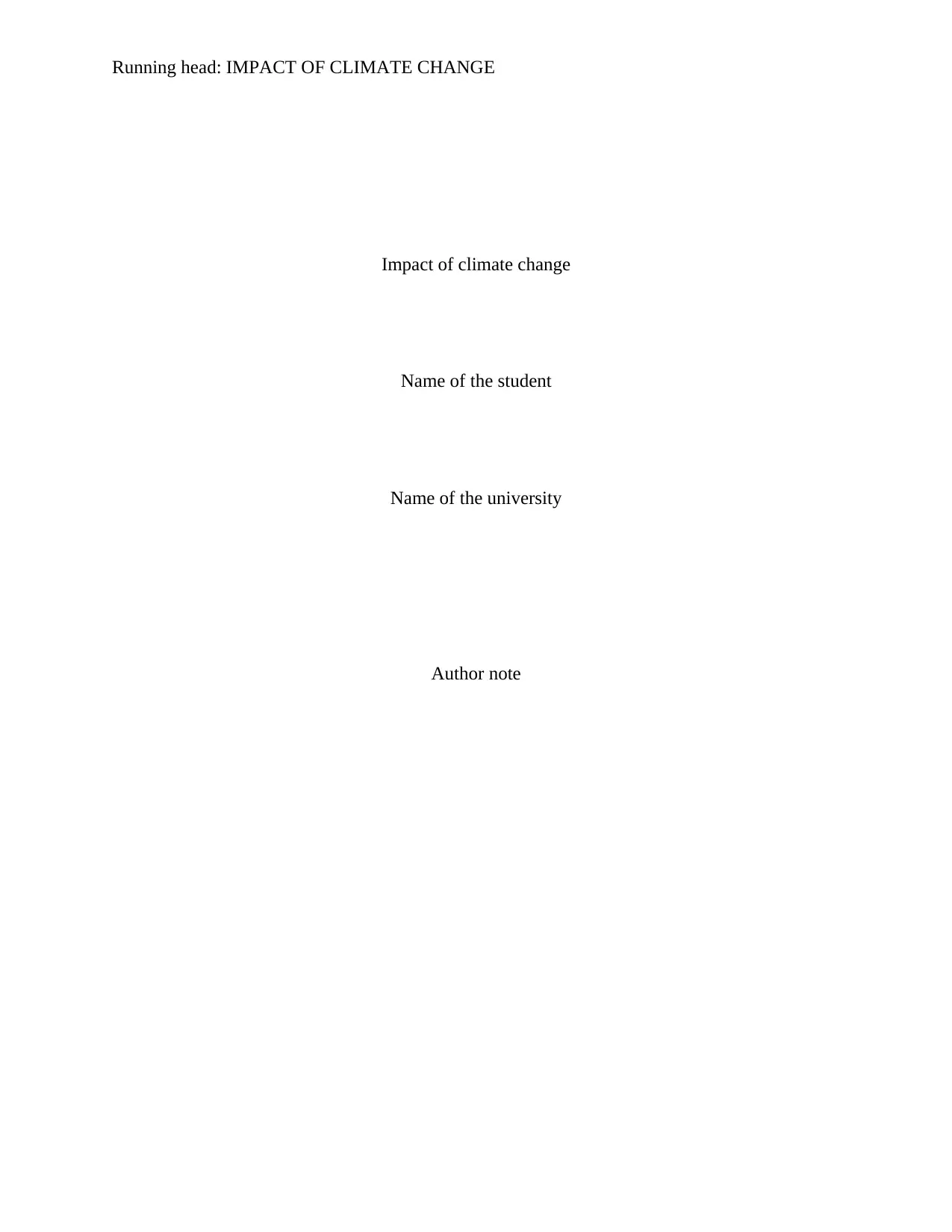
Running head: IMPACT OF CLIMATE CHANGE
Impact of climate change
Name of the student
Name of the university
Author note
Impact of climate change
Name of the student
Name of the university
Author note
Secure Best Marks with AI Grader
Need help grading? Try our AI Grader for instant feedback on your assignments.
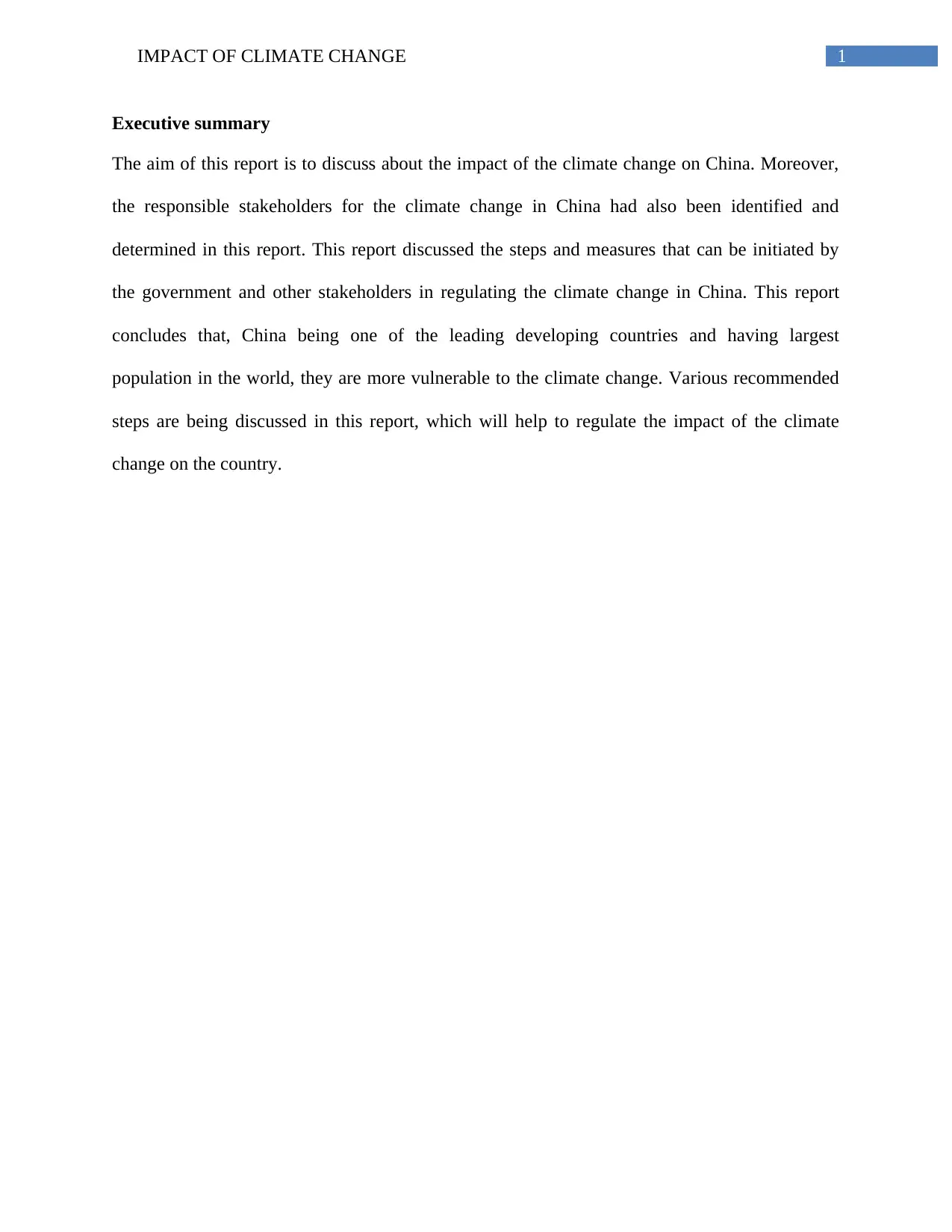
1IMPACT OF CLIMATE CHANGE
Executive summary
The aim of this report is to discuss about the impact of the climate change on China. Moreover,
the responsible stakeholders for the climate change in China had also been identified and
determined in this report. This report discussed the steps and measures that can be initiated by
the government and other stakeholders in regulating the climate change in China. This report
concludes that, China being one of the leading developing countries and having largest
population in the world, they are more vulnerable to the climate change. Various recommended
steps are being discussed in this report, which will help to regulate the impact of the climate
change on the country.
Executive summary
The aim of this report is to discuss about the impact of the climate change on China. Moreover,
the responsible stakeholders for the climate change in China had also been identified and
determined in this report. This report discussed the steps and measures that can be initiated by
the government and other stakeholders in regulating the climate change in China. This report
concludes that, China being one of the leading developing countries and having largest
population in the world, they are more vulnerable to the climate change. Various recommended
steps are being discussed in this report, which will help to regulate the impact of the climate
change on the country.
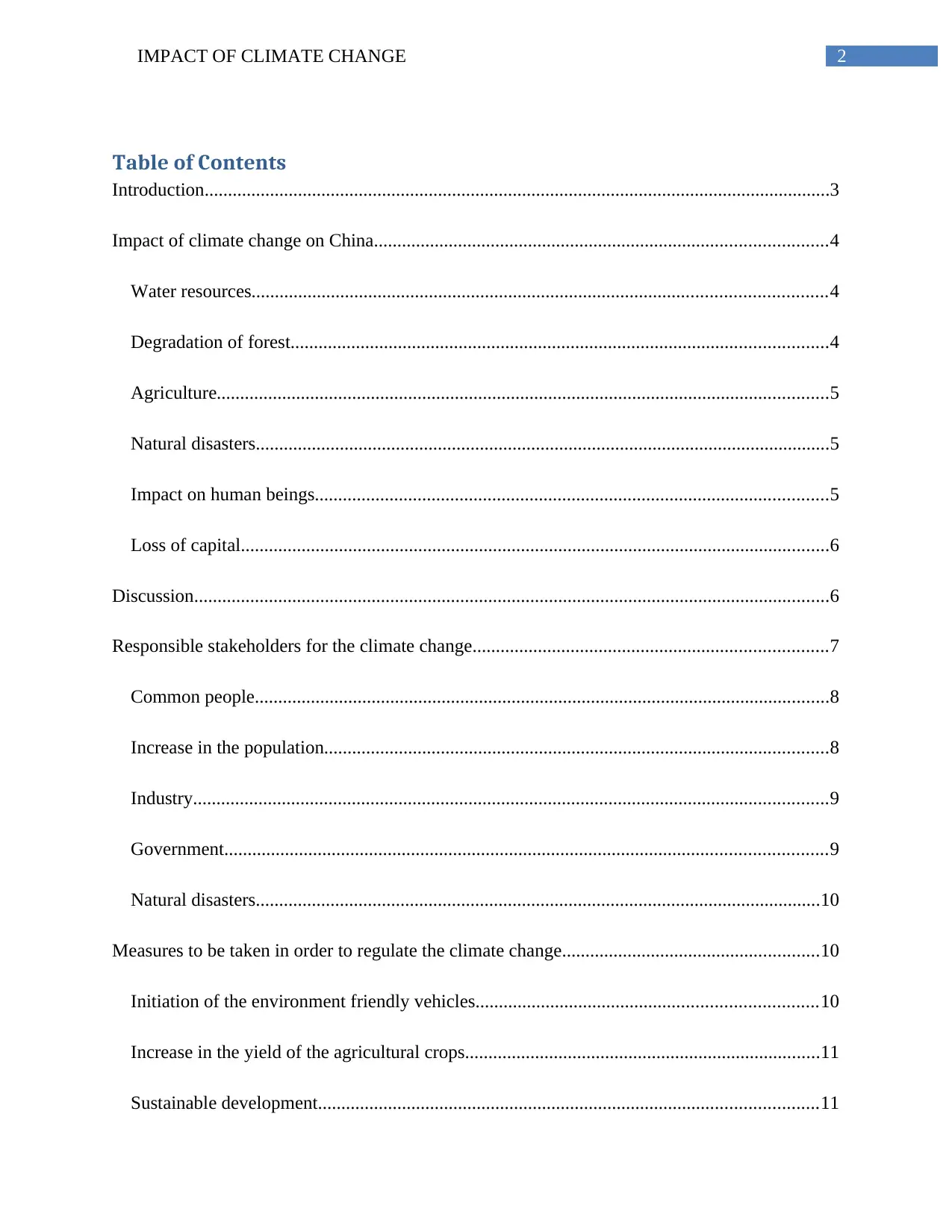
2IMPACT OF CLIMATE CHANGE
Table of Contents
Introduction......................................................................................................................................3
Impact of climate change on China.................................................................................................4
Water resources...........................................................................................................................4
Degradation of forest...................................................................................................................4
Agriculture...................................................................................................................................5
Natural disasters...........................................................................................................................5
Impact on human beings..............................................................................................................5
Loss of capital..............................................................................................................................6
Discussion........................................................................................................................................6
Responsible stakeholders for the climate change............................................................................7
Common people...........................................................................................................................8
Increase in the population............................................................................................................8
Industry........................................................................................................................................9
Government.................................................................................................................................9
Natural disasters.........................................................................................................................10
Measures to be taken in order to regulate the climate change.......................................................10
Initiation of the environment friendly vehicles.........................................................................10
Increase in the yield of the agricultural crops............................................................................11
Sustainable development...........................................................................................................11
Table of Contents
Introduction......................................................................................................................................3
Impact of climate change on China.................................................................................................4
Water resources...........................................................................................................................4
Degradation of forest...................................................................................................................4
Agriculture...................................................................................................................................5
Natural disasters...........................................................................................................................5
Impact on human beings..............................................................................................................5
Loss of capital..............................................................................................................................6
Discussion........................................................................................................................................6
Responsible stakeholders for the climate change............................................................................7
Common people...........................................................................................................................8
Increase in the population............................................................................................................8
Industry........................................................................................................................................9
Government.................................................................................................................................9
Natural disasters.........................................................................................................................10
Measures to be taken in order to regulate the climate change.......................................................10
Initiation of the environment friendly vehicles.........................................................................10
Increase in the yield of the agricultural crops............................................................................11
Sustainable development...........................................................................................................11
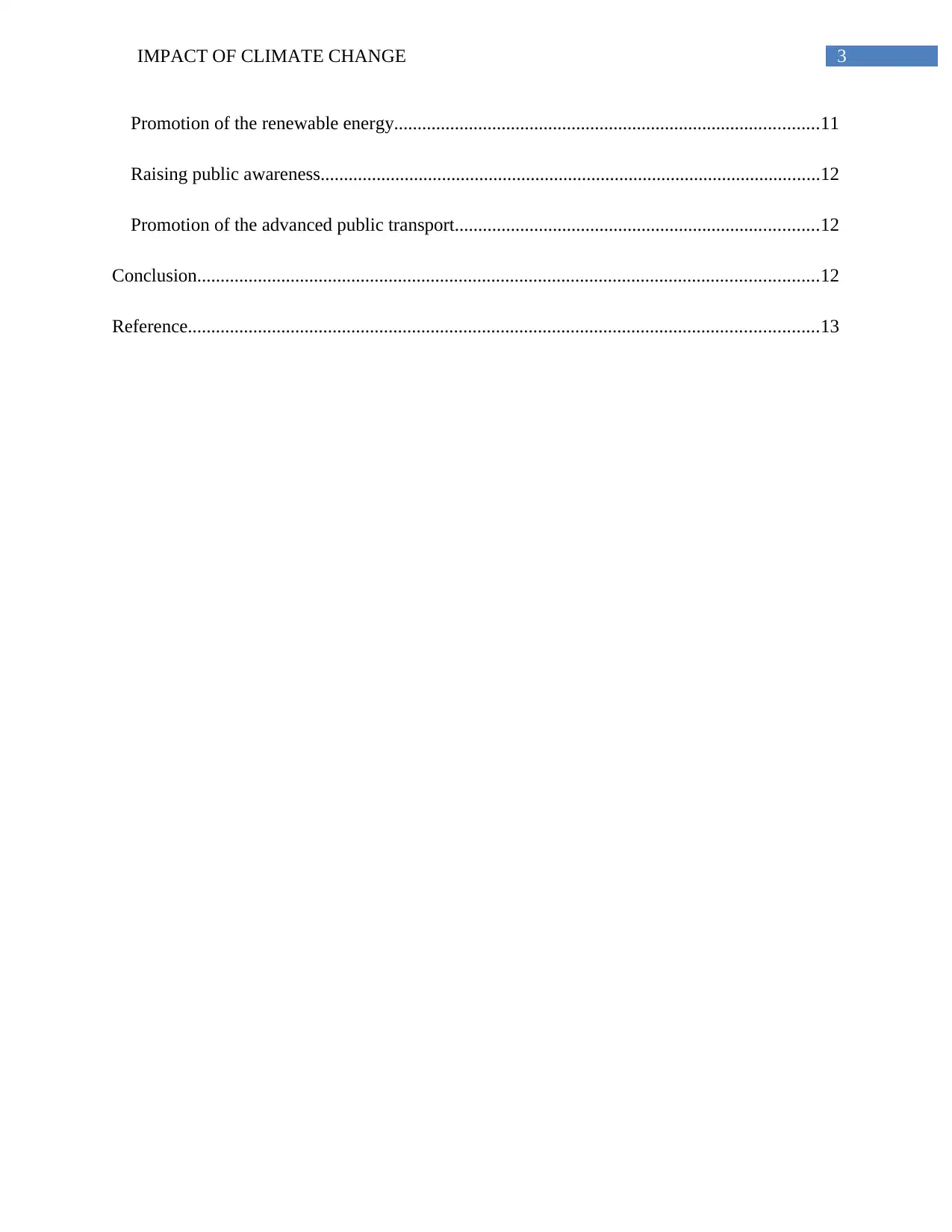
3IMPACT OF CLIMATE CHANGE
Promotion of the renewable energy...........................................................................................11
Raising public awareness...........................................................................................................12
Promotion of the advanced public transport..............................................................................12
Conclusion.....................................................................................................................................12
Reference.......................................................................................................................................13
Promotion of the renewable energy...........................................................................................11
Raising public awareness...........................................................................................................12
Promotion of the advanced public transport..............................................................................12
Conclusion.....................................................................................................................................12
Reference.......................................................................................................................................13
Paraphrase This Document
Need a fresh take? Get an instant paraphrase of this document with our AI Paraphraser
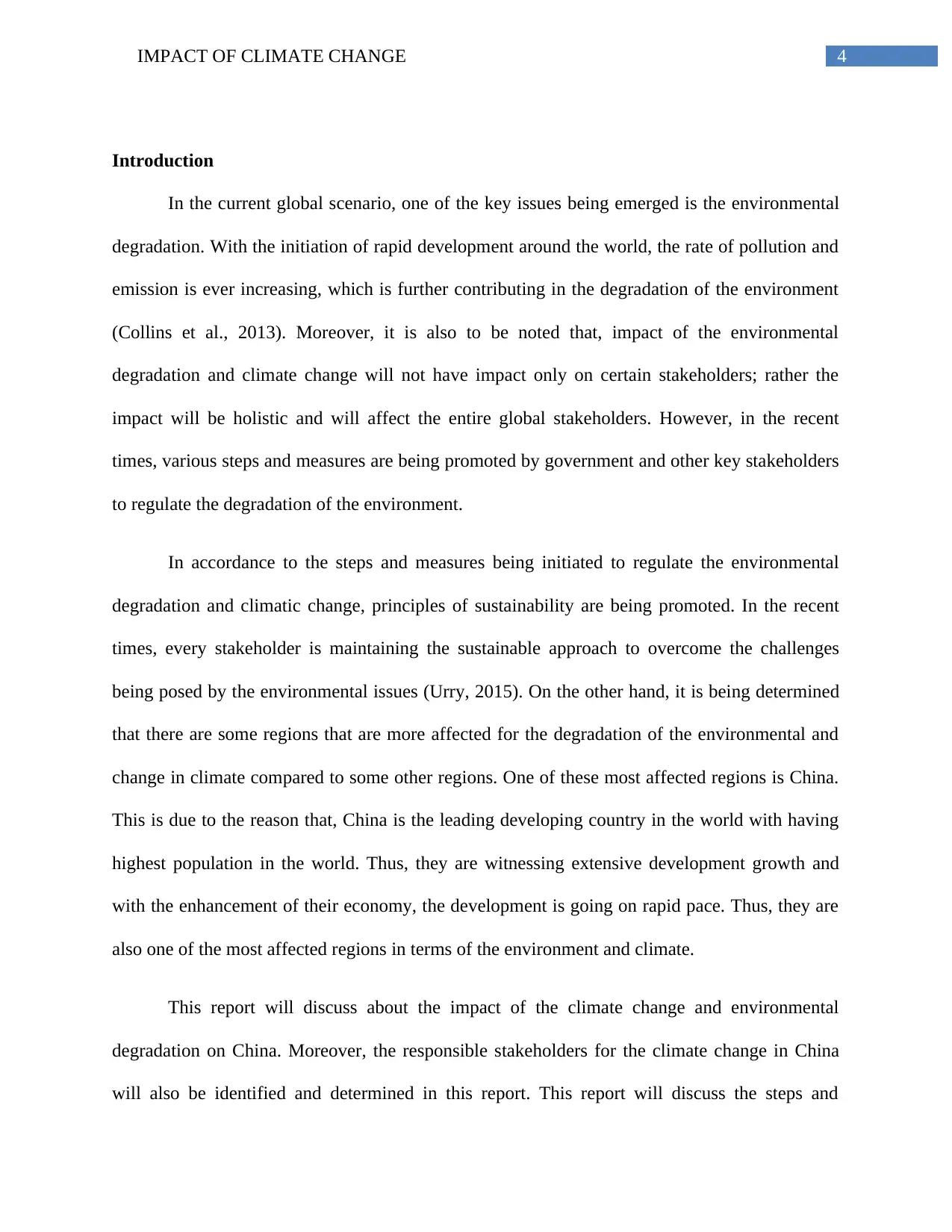
4IMPACT OF CLIMATE CHANGE
Introduction
In the current global scenario, one of the key issues being emerged is the environmental
degradation. With the initiation of rapid development around the world, the rate of pollution and
emission is ever increasing, which is further contributing in the degradation of the environment
(Collins et al., 2013). Moreover, it is also to be noted that, impact of the environmental
degradation and climate change will not have impact only on certain stakeholders; rather the
impact will be holistic and will affect the entire global stakeholders. However, in the recent
times, various steps and measures are being promoted by government and other key stakeholders
to regulate the degradation of the environment.
In accordance to the steps and measures being initiated to regulate the environmental
degradation and climatic change, principles of sustainability are being promoted. In the recent
times, every stakeholder is maintaining the sustainable approach to overcome the challenges
being posed by the environmental issues (Urry, 2015). On the other hand, it is being determined
that there are some regions that are more affected for the degradation of the environmental and
change in climate compared to some other regions. One of these most affected regions is China.
This is due to the reason that, China is the leading developing country in the world with having
highest population in the world. Thus, they are witnessing extensive development growth and
with the enhancement of their economy, the development is going on rapid pace. Thus, they are
also one of the most affected regions in terms of the environment and climate.
This report will discuss about the impact of the climate change and environmental
degradation on China. Moreover, the responsible stakeholders for the climate change in China
will also be identified and determined in this report. This report will discuss the steps and
Introduction
In the current global scenario, one of the key issues being emerged is the environmental
degradation. With the initiation of rapid development around the world, the rate of pollution and
emission is ever increasing, which is further contributing in the degradation of the environment
(Collins et al., 2013). Moreover, it is also to be noted that, impact of the environmental
degradation and climate change will not have impact only on certain stakeholders; rather the
impact will be holistic and will affect the entire global stakeholders. However, in the recent
times, various steps and measures are being promoted by government and other key stakeholders
to regulate the degradation of the environment.
In accordance to the steps and measures being initiated to regulate the environmental
degradation and climatic change, principles of sustainability are being promoted. In the recent
times, every stakeholder is maintaining the sustainable approach to overcome the challenges
being posed by the environmental issues (Urry, 2015). On the other hand, it is being determined
that there are some regions that are more affected for the degradation of the environmental and
change in climate compared to some other regions. One of these most affected regions is China.
This is due to the reason that, China is the leading developing country in the world with having
highest population in the world. Thus, they are witnessing extensive development growth and
with the enhancement of their economy, the development is going on rapid pace. Thus, they are
also one of the most affected regions in terms of the environment and climate.
This report will discuss about the impact of the climate change and environmental
degradation on China. Moreover, the responsible stakeholders for the climate change in China
will also be identified and determined in this report. This report will discuss the steps and
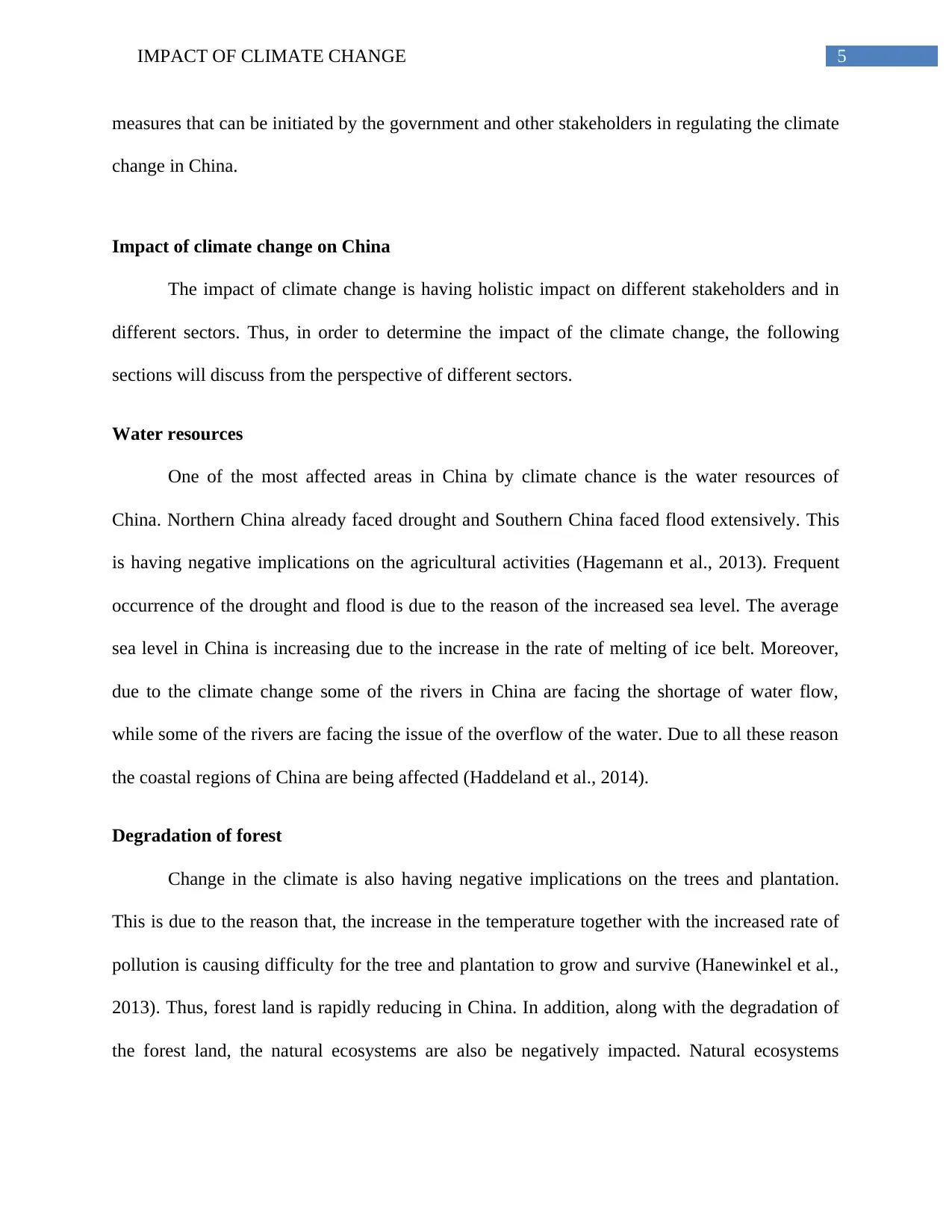
5IMPACT OF CLIMATE CHANGE
measures that can be initiated by the government and other stakeholders in regulating the climate
change in China.
Impact of climate change on China
The impact of climate change is having holistic impact on different stakeholders and in
different sectors. Thus, in order to determine the impact of the climate change, the following
sections will discuss from the perspective of different sectors.
Water resources
One of the most affected areas in China by climate chance is the water resources of
China. Northern China already faced drought and Southern China faced flood extensively. This
is having negative implications on the agricultural activities (Hagemann et al., 2013). Frequent
occurrence of the drought and flood is due to the reason of the increased sea level. The average
sea level in China is increasing due to the increase in the rate of melting of ice belt. Moreover,
due to the climate change some of the rivers in China are facing the shortage of water flow,
while some of the rivers are facing the issue of the overflow of the water. Due to all these reason
the coastal regions of China are being affected (Haddeland et al., 2014).
Degradation of forest
Change in the climate is also having negative implications on the trees and plantation.
This is due to the reason that, the increase in the temperature together with the increased rate of
pollution is causing difficulty for the tree and plantation to grow and survive (Hanewinkel et al.,
2013). Thus, forest land is rapidly reducing in China. In addition, along with the degradation of
the forest land, the natural ecosystems are also be negatively impacted. Natural ecosystems
measures that can be initiated by the government and other stakeholders in regulating the climate
change in China.
Impact of climate change on China
The impact of climate change is having holistic impact on different stakeholders and in
different sectors. Thus, in order to determine the impact of the climate change, the following
sections will discuss from the perspective of different sectors.
Water resources
One of the most affected areas in China by climate chance is the water resources of
China. Northern China already faced drought and Southern China faced flood extensively. This
is having negative implications on the agricultural activities (Hagemann et al., 2013). Frequent
occurrence of the drought and flood is due to the reason of the increased sea level. The average
sea level in China is increasing due to the increase in the rate of melting of ice belt. Moreover,
due to the climate change some of the rivers in China are facing the shortage of water flow,
while some of the rivers are facing the issue of the overflow of the water. Due to all these reason
the coastal regions of China are being affected (Haddeland et al., 2014).
Degradation of forest
Change in the climate is also having negative implications on the trees and plantation.
This is due to the reason that, the increase in the temperature together with the increased rate of
pollution is causing difficulty for the tree and plantation to grow and survive (Hanewinkel et al.,
2013). Thus, forest land is rapidly reducing in China. In addition, along with the degradation of
the forest land, the natural ecosystems are also be negatively impacted. Natural ecosystems

6IMPACT OF CLIMATE CHANGE
including bird and animal species are facing the threat of extinction due to the change in the
climate.
Agriculture
Agriculture is one of those sectors, which is directly influenced by the natural calamities
and mishaps. Thus, due to the increase in the average sea level, forest degradation and irregular
flood and drought are having negative implications on the agricultural activities (Wheeler and
Von Braun, 2013). On the other hand, the production of crops is also being reducing due to the
change in the climate. This is due to the reason that, the crops are not immune to the increased
temperature. It is being estimated that, by 2030, the average production of crops will get reduced
by more than 35 percent. Thus, on one hand, the population is rapidly increasing along with
increase in the demand for food crops and on the other hand the agricultural production is getting
reduced (Kurukulasuriya and Rosenthal, 2013). Thus, it is going to be a challenge for the
populous country such as China.
Natural disasters
Due to the reason of the climate change and degradation of environment, China is also
facing the increased amount of natural disasters such as earthquake, typhoon and flood (Grimm
et al., 2013). Moreover, they are also facing the increased threat of extreme weather conditions.
Thus, china is facing huge economical, infrastructural and social loss due to the frequent
incidents of natural disasters.
Impact on human beings
The majority of the population of China is facing the threat of climate change. This is due
to the reason that, occurrence of flood and other natural disasters is causing loss of life.
including bird and animal species are facing the threat of extinction due to the change in the
climate.
Agriculture
Agriculture is one of those sectors, which is directly influenced by the natural calamities
and mishaps. Thus, due to the increase in the average sea level, forest degradation and irregular
flood and drought are having negative implications on the agricultural activities (Wheeler and
Von Braun, 2013). On the other hand, the production of crops is also being reducing due to the
change in the climate. This is due to the reason that, the crops are not immune to the increased
temperature. It is being estimated that, by 2030, the average production of crops will get reduced
by more than 35 percent. Thus, on one hand, the population is rapidly increasing along with
increase in the demand for food crops and on the other hand the agricultural production is getting
reduced (Kurukulasuriya and Rosenthal, 2013). Thus, it is going to be a challenge for the
populous country such as China.
Natural disasters
Due to the reason of the climate change and degradation of environment, China is also
facing the increased amount of natural disasters such as earthquake, typhoon and flood (Grimm
et al., 2013). Moreover, they are also facing the increased threat of extreme weather conditions.
Thus, china is facing huge economical, infrastructural and social loss due to the frequent
incidents of natural disasters.
Impact on human beings
The majority of the population of China is facing the threat of climate change. This is due
to the reason that, occurrence of flood and other natural disasters is causing loss of life.
Secure Best Marks with AI Grader
Need help grading? Try our AI Grader for instant feedback on your assignments.
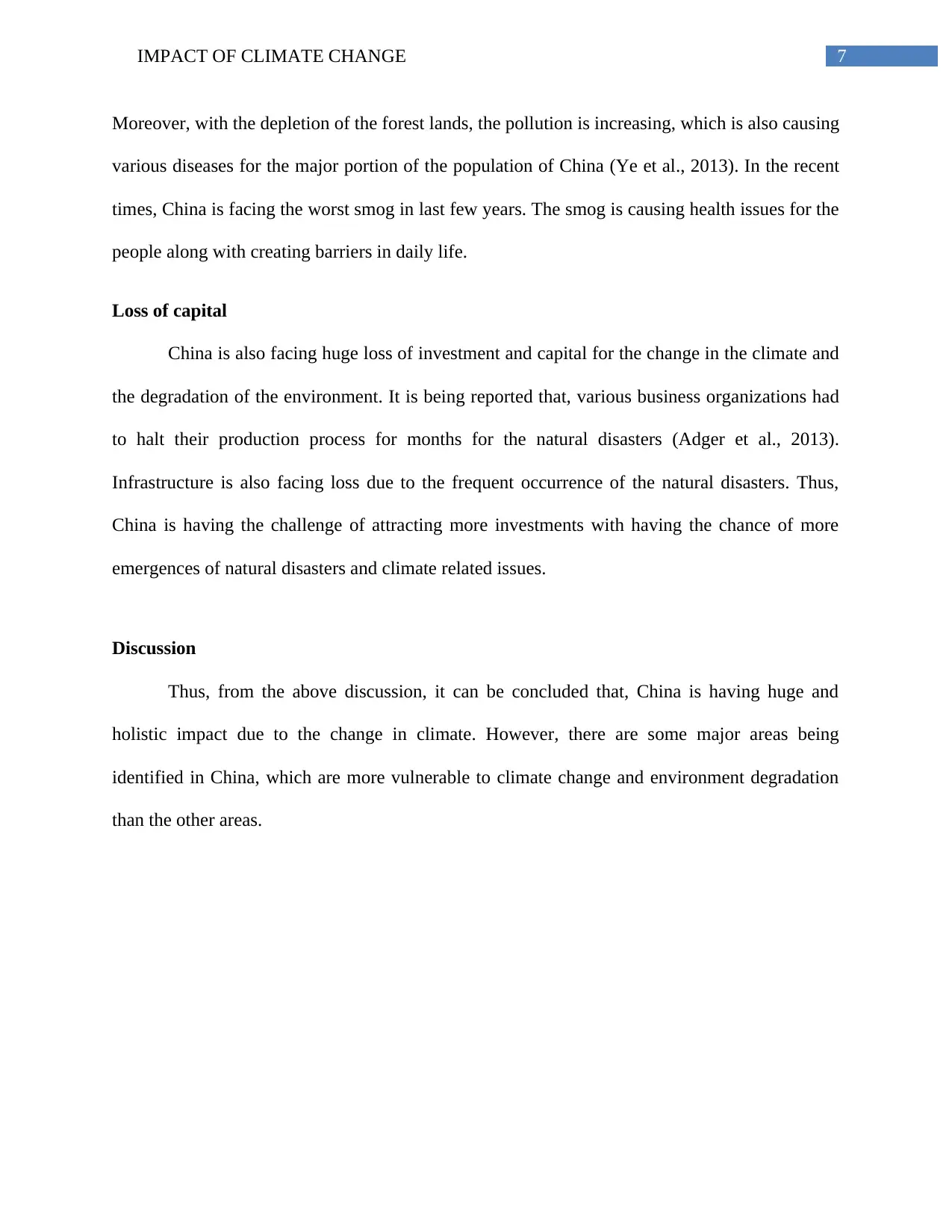
7IMPACT OF CLIMATE CHANGE
Moreover, with the depletion of the forest lands, the pollution is increasing, which is also causing
various diseases for the major portion of the population of China (Ye et al., 2013). In the recent
times, China is facing the worst smog in last few years. The smog is causing health issues for the
people along with creating barriers in daily life.
Loss of capital
China is also facing huge loss of investment and capital for the change in the climate and
the degradation of the environment. It is being reported that, various business organizations had
to halt their production process for months for the natural disasters (Adger et al., 2013).
Infrastructure is also facing loss due to the frequent occurrence of the natural disasters. Thus,
China is having the challenge of attracting more investments with having the chance of more
emergences of natural disasters and climate related issues.
Discussion
Thus, from the above discussion, it can be concluded that, China is having huge and
holistic impact due to the change in climate. However, there are some major areas being
identified in China, which are more vulnerable to climate change and environment degradation
than the other areas.
Moreover, with the depletion of the forest lands, the pollution is increasing, which is also causing
various diseases for the major portion of the population of China (Ye et al., 2013). In the recent
times, China is facing the worst smog in last few years. The smog is causing health issues for the
people along with creating barriers in daily life.
Loss of capital
China is also facing huge loss of investment and capital for the change in the climate and
the degradation of the environment. It is being reported that, various business organizations had
to halt their production process for months for the natural disasters (Adger et al., 2013).
Infrastructure is also facing loss due to the frequent occurrence of the natural disasters. Thus,
China is having the challenge of attracting more investments with having the chance of more
emergences of natural disasters and climate related issues.
Discussion
Thus, from the above discussion, it can be concluded that, China is having huge and
holistic impact due to the change in climate. However, there are some major areas being
identified in China, which are more vulnerable to climate change and environment degradation
than the other areas.
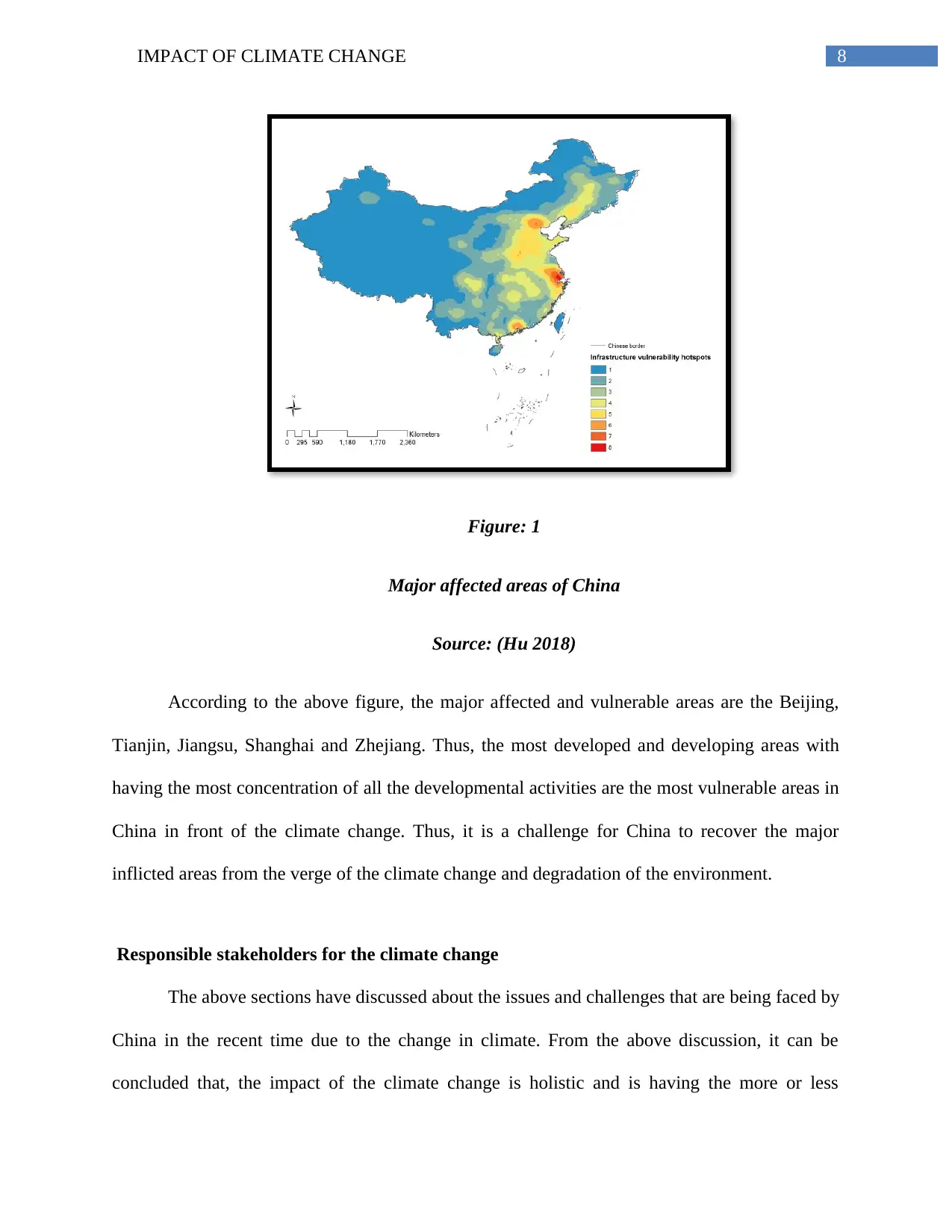
8IMPACT OF CLIMATE CHANGE
Figure: 1
Major affected areas of China
Source: (Hu 2018)
According to the above figure, the major affected and vulnerable areas are the Beijing,
Tianjin, Jiangsu, Shanghai and Zhejiang. Thus, the most developed and developing areas with
having the most concentration of all the developmental activities are the most vulnerable areas in
China in front of the climate change. Thus, it is a challenge for China to recover the major
inflicted areas from the verge of the climate change and degradation of the environment.
Responsible stakeholders for the climate change
The above sections have discussed about the issues and challenges that are being faced by
China in the recent time due to the change in climate. From the above discussion, it can be
concluded that, the impact of the climate change is holistic and is having the more or less
Figure: 1
Major affected areas of China
Source: (Hu 2018)
According to the above figure, the major affected and vulnerable areas are the Beijing,
Tianjin, Jiangsu, Shanghai and Zhejiang. Thus, the most developed and developing areas with
having the most concentration of all the developmental activities are the most vulnerable areas in
China in front of the climate change. Thus, it is a challenge for China to recover the major
inflicted areas from the verge of the climate change and degradation of the environment.
Responsible stakeholders for the climate change
The above sections have discussed about the issues and challenges that are being faced by
China in the recent time due to the change in climate. From the above discussion, it can be
concluded that, the impact of the climate change is holistic and is having the more or less
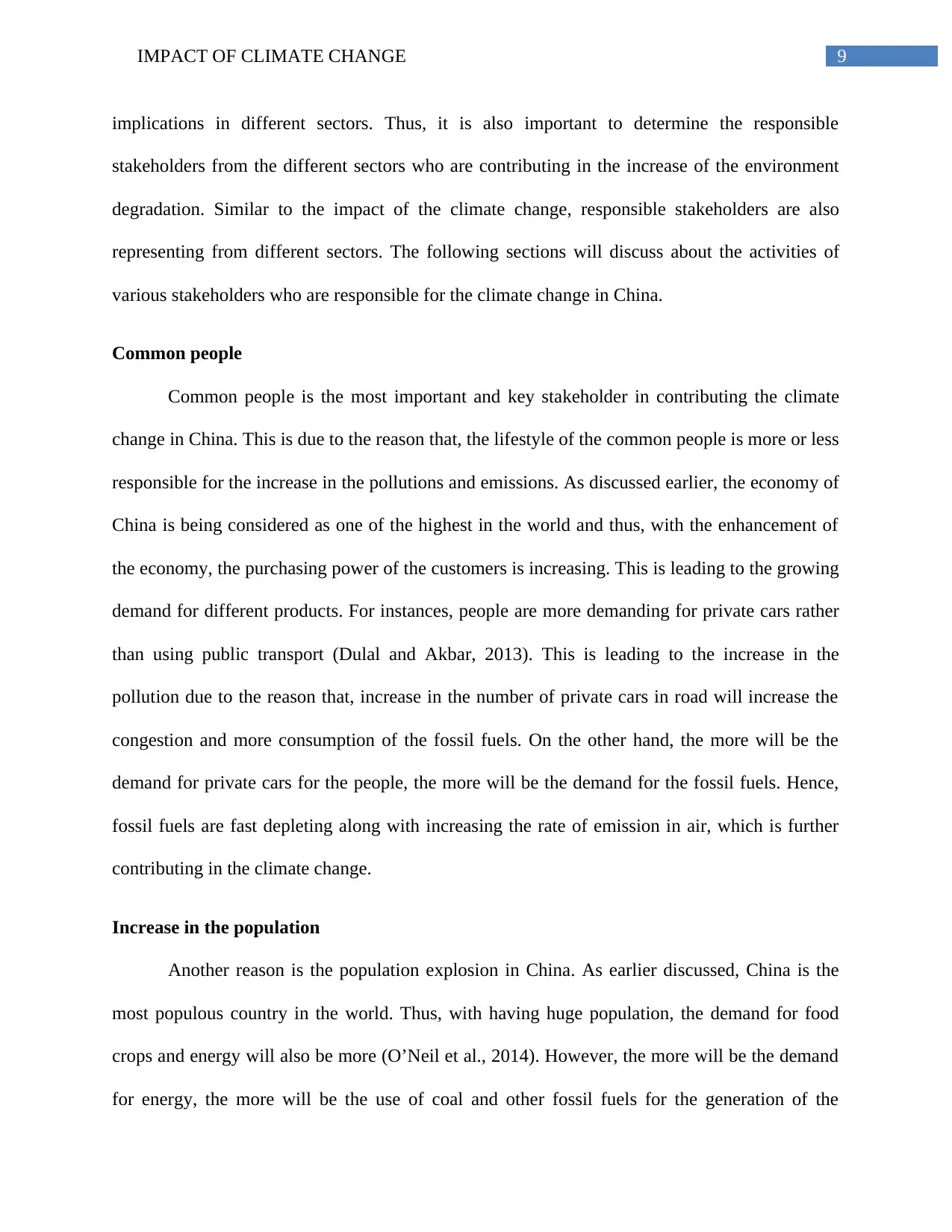
9IMPACT OF CLIMATE CHANGE
implications in different sectors. Thus, it is also important to determine the responsible
stakeholders from the different sectors who are contributing in the increase of the environment
degradation. Similar to the impact of the climate change, responsible stakeholders are also
representing from different sectors. The following sections will discuss about the activities of
various stakeholders who are responsible for the climate change in China.
Common people
Common people is the most important and key stakeholder in contributing the climate
change in China. This is due to the reason that, the lifestyle of the common people is more or less
responsible for the increase in the pollutions and emissions. As discussed earlier, the economy of
China is being considered as one of the highest in the world and thus, with the enhancement of
the economy, the purchasing power of the customers is increasing. This is leading to the growing
demand for different products. For instances, people are more demanding for private cars rather
than using public transport (Dulal and Akbar, 2013). This is leading to the increase in the
pollution due to the reason that, increase in the number of private cars in road will increase the
congestion and more consumption of the fossil fuels. On the other hand, the more will be the
demand for private cars for the people, the more will be the demand for the fossil fuels. Hence,
fossil fuels are fast depleting along with increasing the rate of emission in air, which is further
contributing in the climate change.
Increase in the population
Another reason is the population explosion in China. As earlier discussed, China is the
most populous country in the world. Thus, with having huge population, the demand for food
crops and energy will also be more (O’Neil et al., 2014). However, the more will be the demand
for energy, the more will be the use of coal and other fossil fuels for the generation of the
implications in different sectors. Thus, it is also important to determine the responsible
stakeholders from the different sectors who are contributing in the increase of the environment
degradation. Similar to the impact of the climate change, responsible stakeholders are also
representing from different sectors. The following sections will discuss about the activities of
various stakeholders who are responsible for the climate change in China.
Common people
Common people is the most important and key stakeholder in contributing the climate
change in China. This is due to the reason that, the lifestyle of the common people is more or less
responsible for the increase in the pollutions and emissions. As discussed earlier, the economy of
China is being considered as one of the highest in the world and thus, with the enhancement of
the economy, the purchasing power of the customers is increasing. This is leading to the growing
demand for different products. For instances, people are more demanding for private cars rather
than using public transport (Dulal and Akbar, 2013). This is leading to the increase in the
pollution due to the reason that, increase in the number of private cars in road will increase the
congestion and more consumption of the fossil fuels. On the other hand, the more will be the
demand for private cars for the people, the more will be the demand for the fossil fuels. Hence,
fossil fuels are fast depleting along with increasing the rate of emission in air, which is further
contributing in the climate change.
Increase in the population
Another reason is the population explosion in China. As earlier discussed, China is the
most populous country in the world. Thus, with having huge population, the demand for food
crops and energy will also be more (O’Neil et al., 2014). However, the more will be the demand
for energy, the more will be the use of coal and other fossil fuels for the generation of the
Paraphrase This Document
Need a fresh take? Get an instant paraphrase of this document with our AI Paraphraser
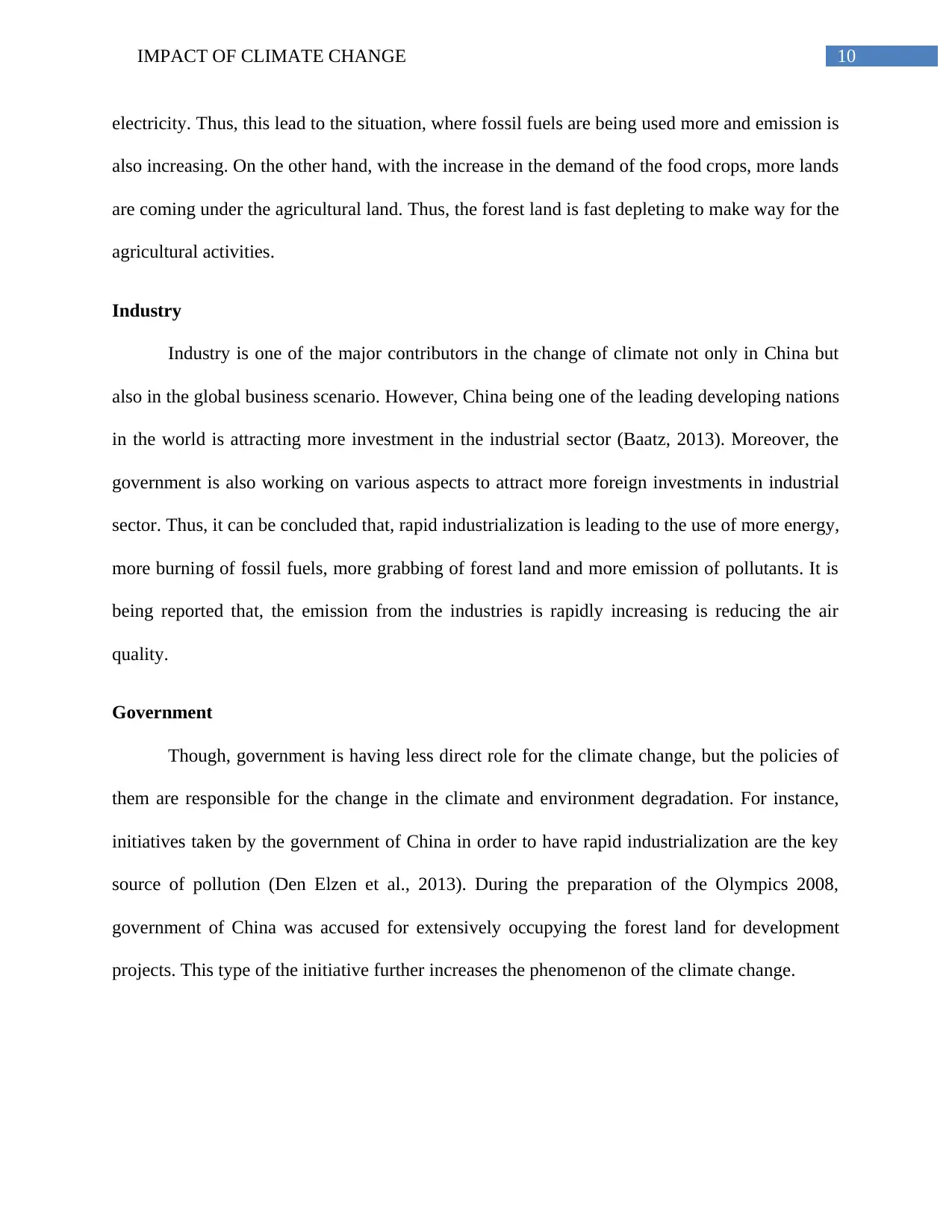
10IMPACT OF CLIMATE CHANGE
electricity. Thus, this lead to the situation, where fossil fuels are being used more and emission is
also increasing. On the other hand, with the increase in the demand of the food crops, more lands
are coming under the agricultural land. Thus, the forest land is fast depleting to make way for the
agricultural activities.
Industry
Industry is one of the major contributors in the change of climate not only in China but
also in the global business scenario. However, China being one of the leading developing nations
in the world is attracting more investment in the industrial sector (Baatz, 2013). Moreover, the
government is also working on various aspects to attract more foreign investments in industrial
sector. Thus, it can be concluded that, rapid industrialization is leading to the use of more energy,
more burning of fossil fuels, more grabbing of forest land and more emission of pollutants. It is
being reported that, the emission from the industries is rapidly increasing is reducing the air
quality.
Government
Though, government is having less direct role for the climate change, but the policies of
them are responsible for the change in the climate and environment degradation. For instance,
initiatives taken by the government of China in order to have rapid industrialization are the key
source of pollution (Den Elzen et al., 2013). During the preparation of the Olympics 2008,
government of China was accused for extensively occupying the forest land for development
projects. This type of the initiative further increases the phenomenon of the climate change.
electricity. Thus, this lead to the situation, where fossil fuels are being used more and emission is
also increasing. On the other hand, with the increase in the demand of the food crops, more lands
are coming under the agricultural land. Thus, the forest land is fast depleting to make way for the
agricultural activities.
Industry
Industry is one of the major contributors in the change of climate not only in China but
also in the global business scenario. However, China being one of the leading developing nations
in the world is attracting more investment in the industrial sector (Baatz, 2013). Moreover, the
government is also working on various aspects to attract more foreign investments in industrial
sector. Thus, it can be concluded that, rapid industrialization is leading to the use of more energy,
more burning of fossil fuels, more grabbing of forest land and more emission of pollutants. It is
being reported that, the emission from the industries is rapidly increasing is reducing the air
quality.
Government
Though, government is having less direct role for the climate change, but the policies of
them are responsible for the change in the climate and environment degradation. For instance,
initiatives taken by the government of China in order to have rapid industrialization are the key
source of pollution (Den Elzen et al., 2013). During the preparation of the Olympics 2008,
government of China was accused for extensively occupying the forest land for development
projects. This type of the initiative further increases the phenomenon of the climate change.
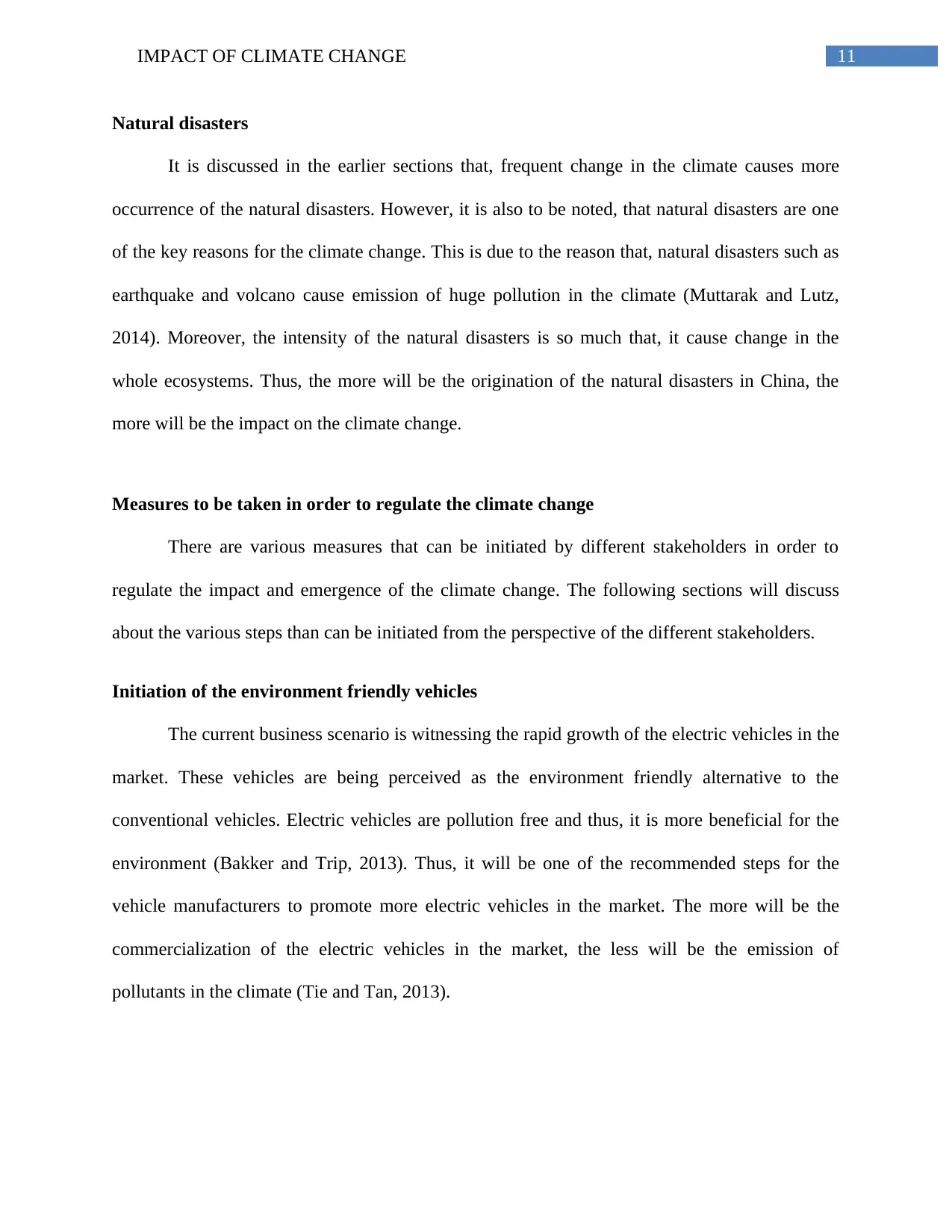
11IMPACT OF CLIMATE CHANGE
Natural disasters
It is discussed in the earlier sections that, frequent change in the climate causes more
occurrence of the natural disasters. However, it is also to be noted, that natural disasters are one
of the key reasons for the climate change. This is due to the reason that, natural disasters such as
earthquake and volcano cause emission of huge pollution in the climate (Muttarak and Lutz,
2014). Moreover, the intensity of the natural disasters is so much that, it cause change in the
whole ecosystems. Thus, the more will be the origination of the natural disasters in China, the
more will be the impact on the climate change.
Measures to be taken in order to regulate the climate change
There are various measures that can be initiated by different stakeholders in order to
regulate the impact and emergence of the climate change. The following sections will discuss
about the various steps than can be initiated from the perspective of the different stakeholders.
Initiation of the environment friendly vehicles
The current business scenario is witnessing the rapid growth of the electric vehicles in the
market. These vehicles are being perceived as the environment friendly alternative to the
conventional vehicles. Electric vehicles are pollution free and thus, it is more beneficial for the
environment (Bakker and Trip, 2013). Thus, it will be one of the recommended steps for the
vehicle manufacturers to promote more electric vehicles in the market. The more will be the
commercialization of the electric vehicles in the market, the less will be the emission of
pollutants in the climate (Tie and Tan, 2013).
Natural disasters
It is discussed in the earlier sections that, frequent change in the climate causes more
occurrence of the natural disasters. However, it is also to be noted, that natural disasters are one
of the key reasons for the climate change. This is due to the reason that, natural disasters such as
earthquake and volcano cause emission of huge pollution in the climate (Muttarak and Lutz,
2014). Moreover, the intensity of the natural disasters is so much that, it cause change in the
whole ecosystems. Thus, the more will be the origination of the natural disasters in China, the
more will be the impact on the climate change.
Measures to be taken in order to regulate the climate change
There are various measures that can be initiated by different stakeholders in order to
regulate the impact and emergence of the climate change. The following sections will discuss
about the various steps than can be initiated from the perspective of the different stakeholders.
Initiation of the environment friendly vehicles
The current business scenario is witnessing the rapid growth of the electric vehicles in the
market. These vehicles are being perceived as the environment friendly alternative to the
conventional vehicles. Electric vehicles are pollution free and thus, it is more beneficial for the
environment (Bakker and Trip, 2013). Thus, it will be one of the recommended steps for the
vehicle manufacturers to promote more electric vehicles in the market. The more will be the
commercialization of the electric vehicles in the market, the less will be the emission of
pollutants in the climate (Tie and Tan, 2013).
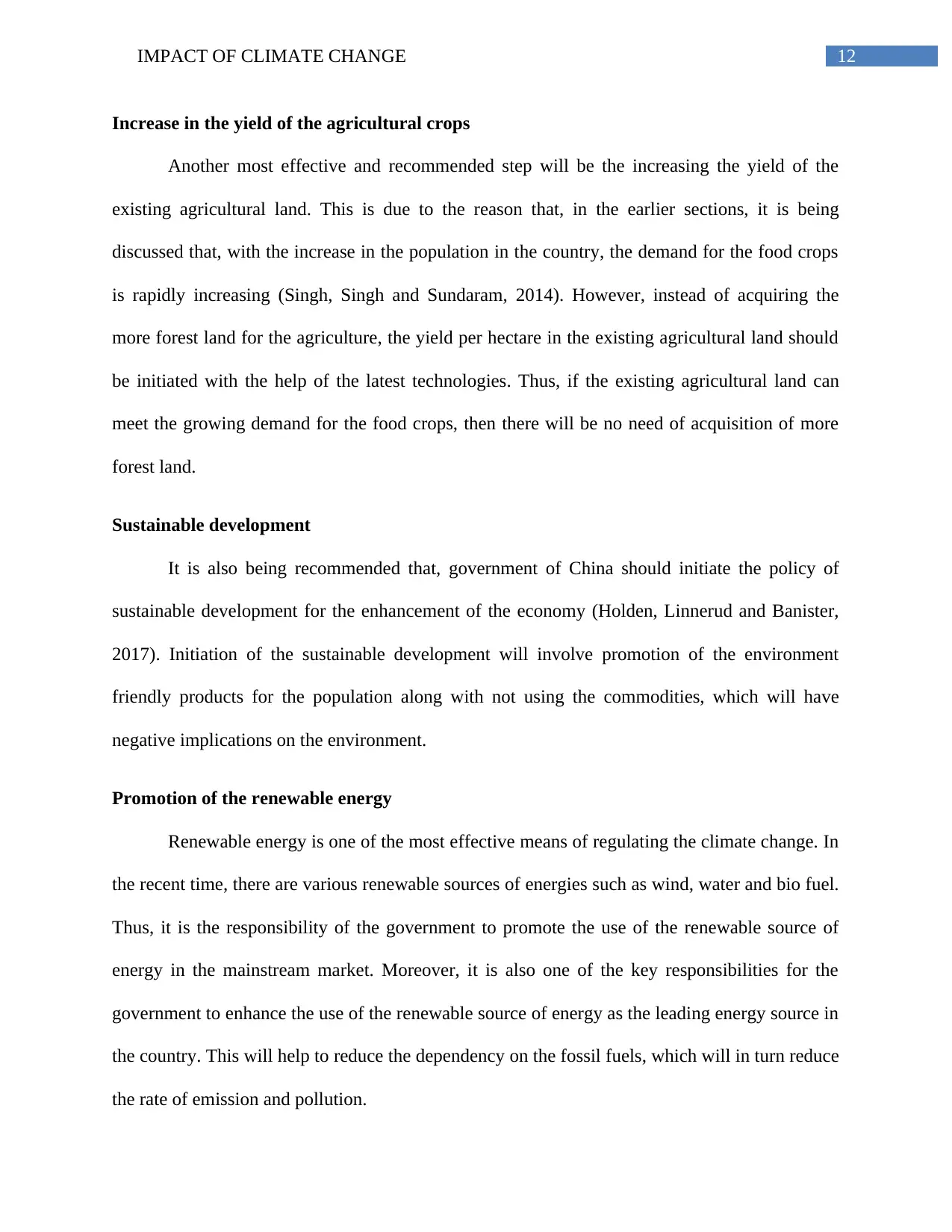
12IMPACT OF CLIMATE CHANGE
Increase in the yield of the agricultural crops
Another most effective and recommended step will be the increasing the yield of the
existing agricultural land. This is due to the reason that, in the earlier sections, it is being
discussed that, with the increase in the population in the country, the demand for the food crops
is rapidly increasing (Singh, Singh and Sundaram, 2014). However, instead of acquiring the
more forest land for the agriculture, the yield per hectare in the existing agricultural land should
be initiated with the help of the latest technologies. Thus, if the existing agricultural land can
meet the growing demand for the food crops, then there will be no need of acquisition of more
forest land.
Sustainable development
It is also being recommended that, government of China should initiate the policy of
sustainable development for the enhancement of the economy (Holden, Linnerud and Banister,
2017). Initiation of the sustainable development will involve promotion of the environment
friendly products for the population along with not using the commodities, which will have
negative implications on the environment.
Promotion of the renewable energy
Renewable energy is one of the most effective means of regulating the climate change. In
the recent time, there are various renewable sources of energies such as wind, water and bio fuel.
Thus, it is the responsibility of the government to promote the use of the renewable source of
energy in the mainstream market. Moreover, it is also one of the key responsibilities for the
government to enhance the use of the renewable source of energy as the leading energy source in
the country. This will help to reduce the dependency on the fossil fuels, which will in turn reduce
the rate of emission and pollution.
Increase in the yield of the agricultural crops
Another most effective and recommended step will be the increasing the yield of the
existing agricultural land. This is due to the reason that, in the earlier sections, it is being
discussed that, with the increase in the population in the country, the demand for the food crops
is rapidly increasing (Singh, Singh and Sundaram, 2014). However, instead of acquiring the
more forest land for the agriculture, the yield per hectare in the existing agricultural land should
be initiated with the help of the latest technologies. Thus, if the existing agricultural land can
meet the growing demand for the food crops, then there will be no need of acquisition of more
forest land.
Sustainable development
It is also being recommended that, government of China should initiate the policy of
sustainable development for the enhancement of the economy (Holden, Linnerud and Banister,
2017). Initiation of the sustainable development will involve promotion of the environment
friendly products for the population along with not using the commodities, which will have
negative implications on the environment.
Promotion of the renewable energy
Renewable energy is one of the most effective means of regulating the climate change. In
the recent time, there are various renewable sources of energies such as wind, water and bio fuel.
Thus, it is the responsibility of the government to promote the use of the renewable source of
energy in the mainstream market. Moreover, it is also one of the key responsibilities for the
government to enhance the use of the renewable source of energy as the leading energy source in
the country. This will help to reduce the dependency on the fossil fuels, which will in turn reduce
the rate of emission and pollution.
Secure Best Marks with AI Grader
Need help grading? Try our AI Grader for instant feedback on your assignments.
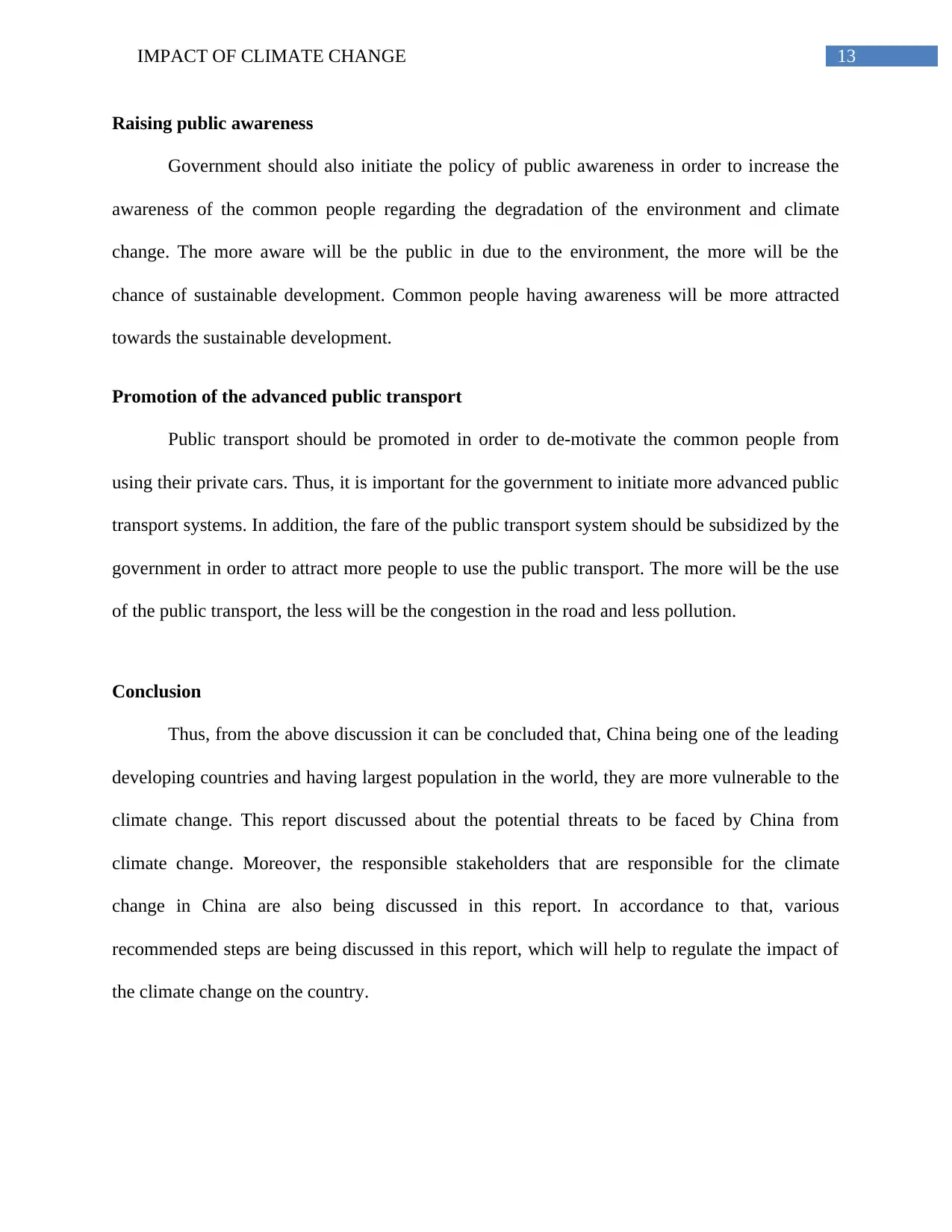
13IMPACT OF CLIMATE CHANGE
Raising public awareness
Government should also initiate the policy of public awareness in order to increase the
awareness of the common people regarding the degradation of the environment and climate
change. The more aware will be the public in due to the environment, the more will be the
chance of sustainable development. Common people having awareness will be more attracted
towards the sustainable development.
Promotion of the advanced public transport
Public transport should be promoted in order to de-motivate the common people from
using their private cars. Thus, it is important for the government to initiate more advanced public
transport systems. In addition, the fare of the public transport system should be subsidized by the
government in order to attract more people to use the public transport. The more will be the use
of the public transport, the less will be the congestion in the road and less pollution.
Conclusion
Thus, from the above discussion it can be concluded that, China being one of the leading
developing countries and having largest population in the world, they are more vulnerable to the
climate change. This report discussed about the potential threats to be faced by China from
climate change. Moreover, the responsible stakeholders that are responsible for the climate
change in China are also being discussed in this report. In accordance to that, various
recommended steps are being discussed in this report, which will help to regulate the impact of
the climate change on the country.
Raising public awareness
Government should also initiate the policy of public awareness in order to increase the
awareness of the common people regarding the degradation of the environment and climate
change. The more aware will be the public in due to the environment, the more will be the
chance of sustainable development. Common people having awareness will be more attracted
towards the sustainable development.
Promotion of the advanced public transport
Public transport should be promoted in order to de-motivate the common people from
using their private cars. Thus, it is important for the government to initiate more advanced public
transport systems. In addition, the fare of the public transport system should be subsidized by the
government in order to attract more people to use the public transport. The more will be the use
of the public transport, the less will be the congestion in the road and less pollution.
Conclusion
Thus, from the above discussion it can be concluded that, China being one of the leading
developing countries and having largest population in the world, they are more vulnerable to the
climate change. This report discussed about the potential threats to be faced by China from
climate change. Moreover, the responsible stakeholders that are responsible for the climate
change in China are also being discussed in this report. In accordance to that, various
recommended steps are being discussed in this report, which will help to regulate the impact of
the climate change on the country.
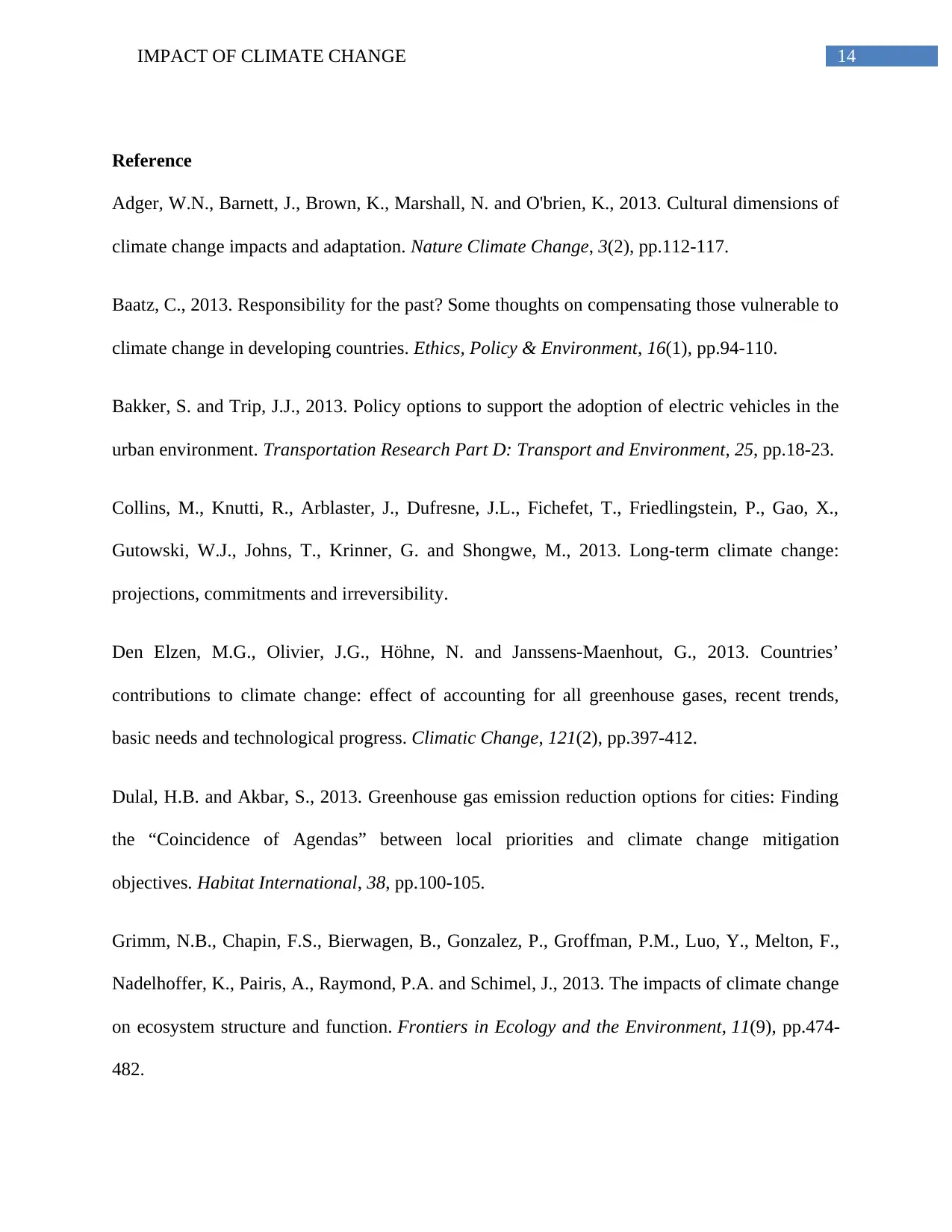
14IMPACT OF CLIMATE CHANGE
Reference
Adger, W.N., Barnett, J., Brown, K., Marshall, N. and O'brien, K., 2013. Cultural dimensions of
climate change impacts and adaptation. Nature Climate Change, 3(2), pp.112-117.
Baatz, C., 2013. Responsibility for the past? Some thoughts on compensating those vulnerable to
climate change in developing countries. Ethics, Policy & Environment, 16(1), pp.94-110.
Bakker, S. and Trip, J.J., 2013. Policy options to support the adoption of electric vehicles in the
urban environment. Transportation Research Part D: Transport and Environment, 25, pp.18-23.
Collins, M., Knutti, R., Arblaster, J., Dufresne, J.L., Fichefet, T., Friedlingstein, P., Gao, X.,
Gutowski, W.J., Johns, T., Krinner, G. and Shongwe, M., 2013. Long-term climate change:
projections, commitments and irreversibility.
Den Elzen, M.G., Olivier, J.G., Höhne, N. and Janssens-Maenhout, G., 2013. Countries’
contributions to climate change: effect of accounting for all greenhouse gases, recent trends,
basic needs and technological progress. Climatic Change, 121(2), pp.397-412.
Dulal, H.B. and Akbar, S., 2013. Greenhouse gas emission reduction options for cities: Finding
the “Coincidence of Agendas” between local priorities and climate change mitigation
objectives. Habitat International, 38, pp.100-105.
Grimm, N.B., Chapin, F.S., Bierwagen, B., Gonzalez, P., Groffman, P.M., Luo, Y., Melton, F.,
Nadelhoffer, K., Pairis, A., Raymond, P.A. and Schimel, J., 2013. The impacts of climate change
on ecosystem structure and function. Frontiers in Ecology and the Environment, 11(9), pp.474-
482.
Reference
Adger, W.N., Barnett, J., Brown, K., Marshall, N. and O'brien, K., 2013. Cultural dimensions of
climate change impacts and adaptation. Nature Climate Change, 3(2), pp.112-117.
Baatz, C., 2013. Responsibility for the past? Some thoughts on compensating those vulnerable to
climate change in developing countries. Ethics, Policy & Environment, 16(1), pp.94-110.
Bakker, S. and Trip, J.J., 2013. Policy options to support the adoption of electric vehicles in the
urban environment. Transportation Research Part D: Transport and Environment, 25, pp.18-23.
Collins, M., Knutti, R., Arblaster, J., Dufresne, J.L., Fichefet, T., Friedlingstein, P., Gao, X.,
Gutowski, W.J., Johns, T., Krinner, G. and Shongwe, M., 2013. Long-term climate change:
projections, commitments and irreversibility.
Den Elzen, M.G., Olivier, J.G., Höhne, N. and Janssens-Maenhout, G., 2013. Countries’
contributions to climate change: effect of accounting for all greenhouse gases, recent trends,
basic needs and technological progress. Climatic Change, 121(2), pp.397-412.
Dulal, H.B. and Akbar, S., 2013. Greenhouse gas emission reduction options for cities: Finding
the “Coincidence of Agendas” between local priorities and climate change mitigation
objectives. Habitat International, 38, pp.100-105.
Grimm, N.B., Chapin, F.S., Bierwagen, B., Gonzalez, P., Groffman, P.M., Luo, Y., Melton, F.,
Nadelhoffer, K., Pairis, A., Raymond, P.A. and Schimel, J., 2013. The impacts of climate change
on ecosystem structure and function. Frontiers in Ecology and the Environment, 11(9), pp.474-
482.
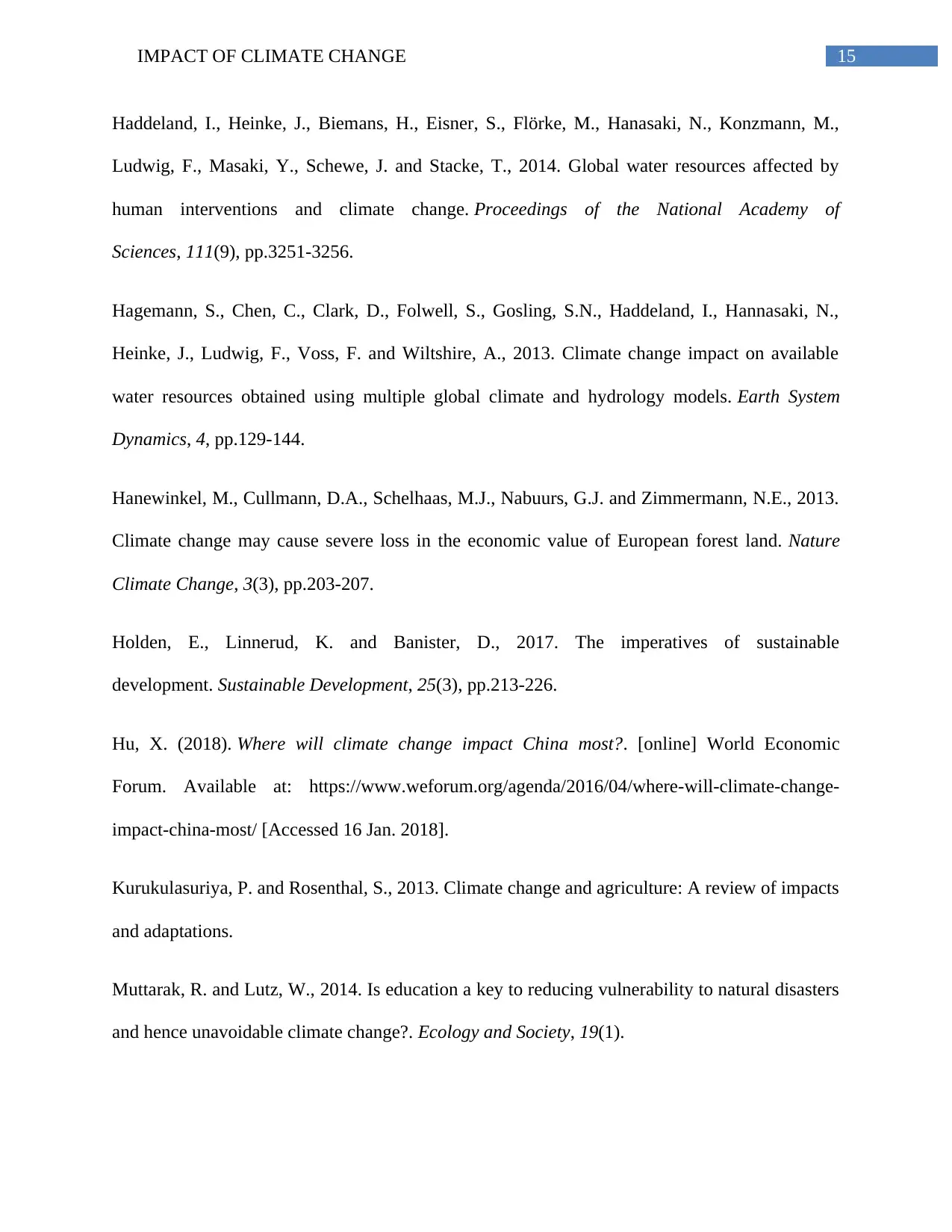
15IMPACT OF CLIMATE CHANGE
Haddeland, I., Heinke, J., Biemans, H., Eisner, S., Flörke, M., Hanasaki, N., Konzmann, M.,
Ludwig, F., Masaki, Y., Schewe, J. and Stacke, T., 2014. Global water resources affected by
human interventions and climate change. Proceedings of the National Academy of
Sciences, 111(9), pp.3251-3256.
Hagemann, S., Chen, C., Clark, D., Folwell, S., Gosling, S.N., Haddeland, I., Hannasaki, N.,
Heinke, J., Ludwig, F., Voss, F. and Wiltshire, A., 2013. Climate change impact on available
water resources obtained using multiple global climate and hydrology models. Earth System
Dynamics, 4, pp.129-144.
Hanewinkel, M., Cullmann, D.A., Schelhaas, M.J., Nabuurs, G.J. and Zimmermann, N.E., 2013.
Climate change may cause severe loss in the economic value of European forest land. Nature
Climate Change, 3(3), pp.203-207.
Holden, E., Linnerud, K. and Banister, D., 2017. The imperatives of sustainable
development. Sustainable Development, 25(3), pp.213-226.
Hu, X. (2018). Where will climate change impact China most?. [online] World Economic
Forum. Available at: https://www.weforum.org/agenda/2016/04/where-will-climate-change-
impact-china-most/ [Accessed 16 Jan. 2018].
Kurukulasuriya, P. and Rosenthal, S., 2013. Climate change and agriculture: A review of impacts
and adaptations.
Muttarak, R. and Lutz, W., 2014. Is education a key to reducing vulnerability to natural disasters
and hence unavoidable climate change?. Ecology and Society, 19(1).
Haddeland, I., Heinke, J., Biemans, H., Eisner, S., Flörke, M., Hanasaki, N., Konzmann, M.,
Ludwig, F., Masaki, Y., Schewe, J. and Stacke, T., 2014. Global water resources affected by
human interventions and climate change. Proceedings of the National Academy of
Sciences, 111(9), pp.3251-3256.
Hagemann, S., Chen, C., Clark, D., Folwell, S., Gosling, S.N., Haddeland, I., Hannasaki, N.,
Heinke, J., Ludwig, F., Voss, F. and Wiltshire, A., 2013. Climate change impact on available
water resources obtained using multiple global climate and hydrology models. Earth System
Dynamics, 4, pp.129-144.
Hanewinkel, M., Cullmann, D.A., Schelhaas, M.J., Nabuurs, G.J. and Zimmermann, N.E., 2013.
Climate change may cause severe loss in the economic value of European forest land. Nature
Climate Change, 3(3), pp.203-207.
Holden, E., Linnerud, K. and Banister, D., 2017. The imperatives of sustainable
development. Sustainable Development, 25(3), pp.213-226.
Hu, X. (2018). Where will climate change impact China most?. [online] World Economic
Forum. Available at: https://www.weforum.org/agenda/2016/04/where-will-climate-change-
impact-china-most/ [Accessed 16 Jan. 2018].
Kurukulasuriya, P. and Rosenthal, S., 2013. Climate change and agriculture: A review of impacts
and adaptations.
Muttarak, R. and Lutz, W., 2014. Is education a key to reducing vulnerability to natural disasters
and hence unavoidable climate change?. Ecology and Society, 19(1).
Paraphrase This Document
Need a fresh take? Get an instant paraphrase of this document with our AI Paraphraser
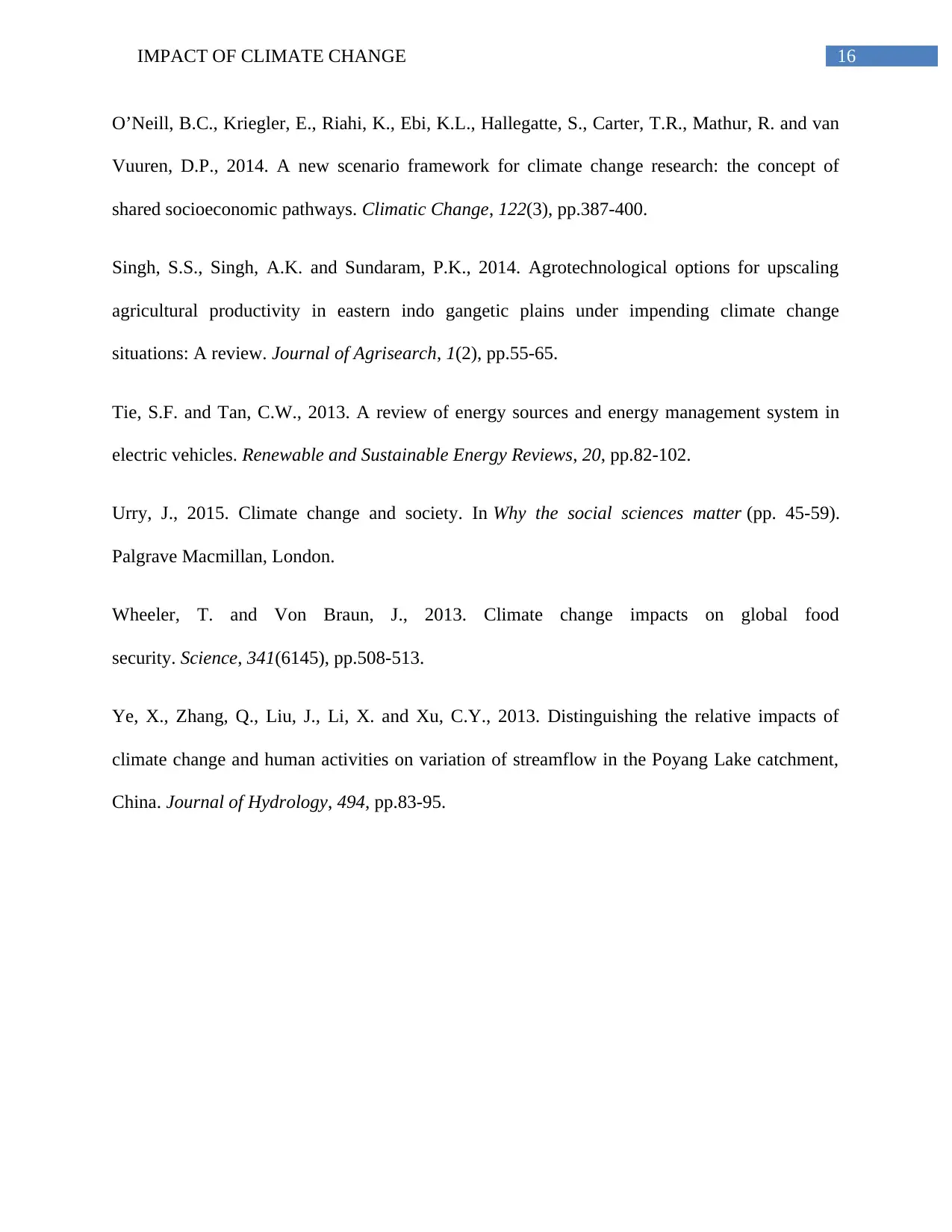
16IMPACT OF CLIMATE CHANGE
O’Neill, B.C., Kriegler, E., Riahi, K., Ebi, K.L., Hallegatte, S., Carter, T.R., Mathur, R. and van
Vuuren, D.P., 2014. A new scenario framework for climate change research: the concept of
shared socioeconomic pathways. Climatic Change, 122(3), pp.387-400.
Singh, S.S., Singh, A.K. and Sundaram, P.K., 2014. Agrotechnological options for upscaling
agricultural productivity in eastern indo gangetic plains under impending climate change
situations: A review. Journal of Agrisearch, 1(2), pp.55-65.
Tie, S.F. and Tan, C.W., 2013. A review of energy sources and energy management system in
electric vehicles. Renewable and Sustainable Energy Reviews, 20, pp.82-102.
Urry, J., 2015. Climate change and society. In Why the social sciences matter (pp. 45-59).
Palgrave Macmillan, London.
Wheeler, T. and Von Braun, J., 2013. Climate change impacts on global food
security. Science, 341(6145), pp.508-513.
Ye, X., Zhang, Q., Liu, J., Li, X. and Xu, C.Y., 2013. Distinguishing the relative impacts of
climate change and human activities on variation of streamflow in the Poyang Lake catchment,
China. Journal of Hydrology, 494, pp.83-95.
O’Neill, B.C., Kriegler, E., Riahi, K., Ebi, K.L., Hallegatte, S., Carter, T.R., Mathur, R. and van
Vuuren, D.P., 2014. A new scenario framework for climate change research: the concept of
shared socioeconomic pathways. Climatic Change, 122(3), pp.387-400.
Singh, S.S., Singh, A.K. and Sundaram, P.K., 2014. Agrotechnological options for upscaling
agricultural productivity in eastern indo gangetic plains under impending climate change
situations: A review. Journal of Agrisearch, 1(2), pp.55-65.
Tie, S.F. and Tan, C.W., 2013. A review of energy sources and energy management system in
electric vehicles. Renewable and Sustainable Energy Reviews, 20, pp.82-102.
Urry, J., 2015. Climate change and society. In Why the social sciences matter (pp. 45-59).
Palgrave Macmillan, London.
Wheeler, T. and Von Braun, J., 2013. Climate change impacts on global food
security. Science, 341(6145), pp.508-513.
Ye, X., Zhang, Q., Liu, J., Li, X. and Xu, C.Y., 2013. Distinguishing the relative impacts of
climate change and human activities on variation of streamflow in the Poyang Lake catchment,
China. Journal of Hydrology, 494, pp.83-95.
1 out of 17
Related Documents
Your All-in-One AI-Powered Toolkit for Academic Success.
+13062052269
info@desklib.com
Available 24*7 on WhatsApp / Email
![[object Object]](/_next/static/media/star-bottom.7253800d.svg)
Unlock your academic potential
© 2024 | Zucol Services PVT LTD | All rights reserved.





